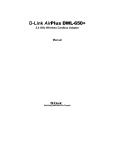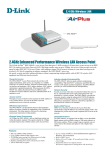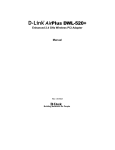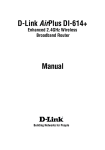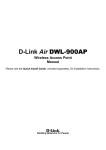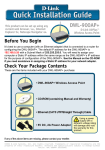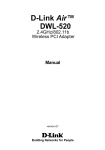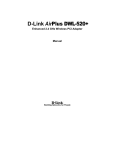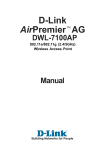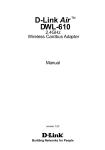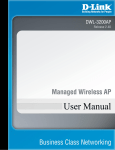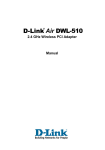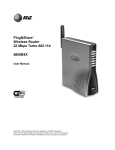Download D-Link AirPlus DWL-900AP Specifications
Transcript
D-Link AirPlus DWL-900AP+ 2.4 GHz Wireless Access Point Manual Rev. 101102 Building Networks for People Contents 1. Package Contents ...................................... 3 2. Introduction .................................................. 4 3. Wireless Basics ........................................... 7 4. Getting Started .......................................... 10 5. Using the Configuration Menu .............. 12 6. Using the AirPlus AP Manager.............. 23 7. Troubleshooting ........................................ 27 8. Networking Basics ................................... 32 9. Technical Specifications ........................ 66 10. Contacting Technical Support ............. 68 11. Warranty and Registration ................... 69 2 1. Package Contents Contents of Package: D-Link AirPlus DWL-900AP+ Enhanced 2.4GHz Wireless Access Point Power Supply – 5V DC, 2.0A Manual on CD Quick Installation Guide Ethernet Cable Note: Using a power supply with a different voltage rating than the one included with the DWL-900AP+ will cause damage and void the warranty for this product. If any of the above items are missing, please contact your reseller. System Requirements: Computer with Windows, Macintosh, or Linux-based operating system with an installed Ethernet adapter Internet Explorer or Netscape Navigator version 4.0 or above, with JavaScript enabled 2. Introduction The D-Link AirPlus DWL-900AP+ Wireless Access Point is an enhanced 802.11b high-performance wireless access point. It is an ideal way to extend the reach and number of computers connected to your wireless network. Unlike most 802.11b access points, the DWL-900AP+ is capable of data transfer speeds of up to 22 Mbps (compared to the standard 11 Mbps) when used with other D-Link AirPlus products such as the DWL-520+ Wireless PCI Adapter. After completing the steps outlined in the Quick Installation Guide (included in your package) you will have the ability to share information and resources, such as files and printers, and enjoy the freedom that wireless networking delivers. The DWL-900AP+ is compatible with most popular operating systems, including Macintosh, Linux and Windows, and can be integrated into a large network. This Manual is designed to help you connect the Access Point and the D-Link AirPlus 2.4GHz Wireless Adapters into a network in Infrastructure mode. Please take a look at the Getting Started section in this manual to see an example of an Infrastructure network using the DWL-900AP+. This manual provides a quick introduction to wireless technology and its application as it relates to networking. Please take a moment to read through this manual and get acquainted with wireless technology. Connections MDII RJ-45 Ethernet Port Straight-Through cable is required when connecting to a router or switch Cross-Over cable is required to connect to a computer Power Reset Button 4 Features & Benefits Up to 2X Faster with AirPlus Products - high-speed wireless data transfer rates up to 22Mbps. With twice the data rate and capacity, the DWL-900AP+ delivers media rich content such as digital images, videos, and MP3 files much faster than standard 802.11b networks Fully 802.11b Compatible – Fully compatible with the IEEE 802.11b standard and interoperable with all existing 802.11b compliant devices Improved Performance – Up to 20% faster data transfer rates on standard 802.11b networks Stronger Network Security with 256-bit WEP Encryption – Supports 64/128/256-bit WEP encryption for higher level of security for your data and wireless communication than encryption found in existing 802.11b products Built-in DHCP Server – If enabled, it will automatically assign IP addresses to wireless clients in a temporary network. Web-based interface for Managing and Configuring – Easy-to-use interface independent of the operating system 4 Different Operation Modes – Capable of operating in one of four different operation modes to meet your wireless networking requirements: Access Point, AP-to-AP Bridging, AP-to-Multipoint Bridging, and Wireless Client. LEDS LED stands for Light-Emitting Diode. The DWL-900AP+ Wireless Access Point has 3 LEDs as shown below: LAN WLAN Power Power: solid green light indicates connection LAN: blinking green light indicates activity; solid green light indicates connection WLAN: blinking green light indicates wireless activity; solid green light indicates connection 6 3. Wireless Basics D-Link AirPlus wireless products are based on industry standards to provide easy-to-use and compatible high-speed wireless connectivity within your home, business or public access wireless networks. Strictly adhering to the IEEE standard, the D-Link AirPlus wireless family of products will allow you to securely access the data you want, when and where you want it. You will be able to enjoy the freedom that wireless networking delivers. A wireless local area network (WLAN) is a cellular computer network that transmits and receives data with radio signals instead of wires. Wireless LANs are used increasingly in both home and office environments, and public areas such as airports, coffee shops and universities. Innovative ways to utilize WLAN technology are helping people to work and communicate more efficiently. Increased mobility and the absence of cabling and other fixed infrastructure have proven to be beneficial for many users. Wireless users can use the same applications they use on a wired network. Wireless adapter cards used on laptop and desktop systems support the same protocols as Ethernet adapter cards. Under many circumstances, it may be desirable for mobile network devices to link to a conventional Ethernet LAN in order to use servers, printers or an Internet connection supplied through the wired LAN. A Wireless Access Point (AP) is a device used to provide this link. People use wireless LAN technology for many different purposes: Mobility - Productivity increases when people have access to data in any location within the operating range of the WLAN. Management decisions based on real-time information can significantly improve worker efficiency. Low Implementation Costs – WLANs (Wireless Local Area Networks) are easy to set up, manage, change and relocate. Networks that frequently change, both physically and logically, can benefit from WLANs ease of implementation. WLANs can operate in locations where installation of wiring may be impractical. Installation Speed and Simplicity - Installing a wireless LAN system can be fast and easy and can eliminate the need to pull cable through walls and ceilings. Wireless Basics Network Expansion - Wireless technology allows the network to go where wires cannot go. Reduced Cost-of-Ownership - While the initial investment required for wireless LAN hardware might be higher than the cost of wired LAN hardware, overall installation expenses and life-cycle costs will be significantly lower. Long-term cost benefits are greatest in dynamic environments requiring frequent moves, adds, and changes. Scalability – Wireless Local Area Networks (WLANs) can be configured in a variety of topologies to meet the needs of specific applications and installations. Configurations are easily changed and range from peer-to-peer networks suitable for a small number of users to full infrastructure networks of thousands of users that allow roaming over a broad area. D-Link AirPlus Wireless Family of LAN products include: Enhanced 2.4GHz Wireless Cardbus Adapters used with laptop computers (DWL-650+) Enhanced 2.4GHz Wireless PCI cards used with desktop computers (DWL-520+) Enhanced 2.4GHz Wireless Access Points (DWL-900AP+) Enhanced 2.4GHz Wireless Broadband Router (DI-614+) The DWL-900AP+ will also work with D-Link Air 802.11b wireless adapters, which include: 2.4GHz Wireless Cardbus Adapters used with laptop computers (DWL-650) 2.4GHz Wireless PCI cards used with desktop computers (DWL-520) Standards - Based Technology The IEEE standard-based technology assures that the D-Link AirPlus Products are interoperable with existing compatible 2.4GHz wireless technology. This means you will be able to transfer large files quickly or even watch a movie in MPEG format over your network without noticeable delays. The technology works by using multiple frequencies in the 2.4GHz range at speeds up to 22 Mbps. D-Link AirPlus products will automatically 8 sense the best possible connection speed to ensure optimal network performance. Installation Considerations Designed to go up to 1,312 feet (400 meters) outdoors and up to 328 feet (100 meters) indoors, D-Link’s AirPlus DWL-900AP+ lets you access your network using a wireless connection from virtually anywhere. Keep in mind, however, that the number, thickness and location of walls, ceilings or other objects that the wireless signals must pass through may limit the range. Typical ranges vary depending on the types of materials and background RF (radio frequency) noise in your home or business. The key to maximizing wireless range is to follow these basic guidelines: 1. Keep the number of walls and ceilings between the wireless Access Point and your receiving device (e.g., the DWL-650+) to a minimum Each wall or ceiling can reduce your D-Link AirPlus Wireless product’s range from 3-90 feet (1-30 meters.) Position your Access Points, Residential Gateways, and computers so that the number of walls or ceilings is minimized. 2. Be aware of the direct line between Access Points, Residential Gateways (routers) and computers. A wall that is 1.5 feet thick (.5 meters), at a 45-degree angle appears to be almost 3 feet (1 meter) thick. At a 2-degree angle it looks over 42 feet (14 meters) thick! Try to make sure that the Access Points and adapters are positioned so that the signal will travel straight through a wall or ceiling for better reception. 3. Building Materials make a difference - A solid metal door or aluminum studs may have a negative effect on range. Try to position Access Points, and computers with wireless adapters so that the signal passes through drywall or open doorways and not other materials. 4. Make sure that the device’s antenna is positioned for best reception by using the software signal strength tools included with your product. 5. Keep your product away (at least 3-6 feet or 1-2 meters) from electrical devices or appliances that may generate extreme RF noise. For the average home, signal range should not be an issue. If you experience low or no signal strength in areas of your home that you wish to access, consider positioning the Access Point in a location directly between the computers with wireless adapters. Additional Access Points can be connected to provide better coverage in rooms where the signal does not appear as strong as desired. 4. Getting Started Right out of the box, with its default settings, the DWL-900AP+ will automatically connect with other D-Link Air or AirPlus products. For the price of a single IP Address from your Broadband Internet Service provider you can share the Internet with all the computers on your local network, without sacrificing speed or security, using D-Link AirPlus networking products. IP ADDRESS Please note: If you have a DHCP-capable router, such as the DLink DI-604 or DI-614+, there is no need to assign an IP Address. If you need to assign IP Addresses to the computers on the network, please remember that the IP Address for each computer must be in the same IP Address range as all the computers in the network, and the Subnet mask must be exactly the same for all the computers in the network. For example: If the first computer is assigned an IP Address of 192.168.0.2 with a Subnet Mask of 255.255.255.0, then the second computer can be assigned an IP Address of 192.168.0.3 with a Subnet Mask of 255.255.255.0, etc. IMPORTANT: If computers or other devices are assigned the same IP Address, one or more of the devices may not be visible on the network. An Infrastructure network contains an Access Point. The Infrastructure Network example shown on the next page contains the following D-Link network devices: A wireless Access Point - D-Link AirPlus DWL-900AP+ An Ethernet Broadband Router - D-Link DI-604 A laptop computer with a wireless adapter - D-Link AirPlus DWL-650+ A desktop computer with a wireless adapter - D-Link AirPlus DWL-520+ A Cable modem - D-Link DCM-200 DHCP stands for Dynamic Host Configuration Protocol. It is a protocol for assigning dynamic IP addresses “automatically.” With a DHCP-capable gateway/router, there is no need to manually assign an IP address. 10 Getting Started Setting Up an Infrastructure Network Please refer to the following sections of this manual for additional information about setting up a network: Networking Basics- learn how to check your IP Address; share printers and files. Using the Configuration Utility- learn the settings you must use on each computer in your network for successful communication. Troubleshooting- learn how to check for the proper installation of the network adapters’ drivers and other tips for troubleshooting the network. Please remember that D-Link AirPlus wireless devices are pre-configured to connect together, right out of the box, with the default settings. You will need a broadband Internet access (Cable/DSL) subscription. Consult with your Cable/DSL provider for proper installation of the modem. Connect the modem to an Ethernet Broadband Router (such as the D-Link DI-604) See the Quick Installation Guide included with the DI-604. Connect the router to the D-Link AirPlus DWL-900AP+. Refer to the Quick Installation Guide for setting up the DWL-900AP+. If you are connecting a desktop computer in your network, you can install the D-Link AirPlus DWL-520+ wireless PCI adapter into an available PCI slot. See the Quick Installation Guide included with the DWL-520+. Install the drivers for the wireless cardbus adapter (D-Link AirPlus DWL-650+) into the laptop computer. See the Quick Installation Guide included with the DWL-650+ for installation instructions. 5. Using the Configuration Menu The Configuration Menu for the DWL-900AP+ is web-based. When using the configuration program, please consider the following: You will need a JavaScript-enabled web-browser such as Internet Explorer 4.0 or higher, or Netscape Navigator 4.0 or higher. The computer that you are using for initial configuration must have an IP Address within the same range as the IP Address of the DWL-900AP+. The DWL-900AP+ has a default IP Address of 192.168.0.50 with subnet mask of 255.255.255.0 If you are using a D-Link router in your network, such as the DI-604, with the factory default settings, you will not need to assign a static IP Address to the computer that you are using to configure the Access Point. (Skip to Fig. 5.1: entering the IP address) If you are not using a D-Link router in your network, you will need to assign a Static IP Address to the computer that you are using to configure the DWL900AP+, within the IP Address Range of the DWL-900AP+. Assign a static IP address of 192.168.0.2 with subnet mask of 255.255.255.0 (Please see Networking Basics in this manual for information on Assigning a Static IP Address.) Note: Please write down the current IP address settings of the computer. You may need to revert back to these settings after configuring the DWL-900AP+. After you have assigned a Static IP Address to the computer you are using for configuration (if necessary), next you will assign the DWL-900AP+ an IP Address within the range of your existing network. After changing the DWL-900AP+’s IP Address, you must revert back to the original IP address in order to regain connection to the DWL-900AP+. If the computer had a static IP address, re-input that same address. If the computer had a dynamic IP Address (i.e., a DHCP capable router automatically assigns the IP Address) then change the setting of your network adapter to receive a Dynamic IP Address. Factory Default Settings for the DWL-900AP+ SSID Channel Encryption User Name Password default 6 disabled admin IP Address 192.168.0.50 (no password, leave field blank) 12 Using the Configuration Menu Whenever you want to configure your network or the DWL-900AP+, you can access the Configuration Utility by opening the web-browser and typing in the IP Address of the DWL-900AP+. The DWL-900AP+’s default IP Address is shown below: Open the web browser Type in the IP Address of the Access Point Fig. 5.1 (The IP Address shown in the example above is the default setting. Use this IP address when connecting to a network consisting of other D-Link devices set to their default settings. If you have changed the IP Address of the DWL-900AP+ to conform to a network other than one with D-Link devices, then input that IP Address in the web browser, instead of the default IP Address shown.) Type admin in the User Name field Leave the Password blank Click OK Fig. 5.2 Home > Wireless The Configuration window will appear. You can select from several options in this window. Here the Home > Wireless tab is displayed. If you wish to change the default settings, you can make changes to the following items: AP name SSID Channel WEP Encryption Key Type Fig. 5.3 Using the Configuration Menu AP Name: You may choose to rename your Access Point, especially if you have more than one Access Point on your network. SSID: (Service Set Identifier) “default” is the default setting. The SSID is a unique name that identifies a network. All devices on a network must share the same SSID name in order to communicate on the network. If you choose to change the SSID from the default setting, input your new SSID name in this field. The SSID can be up to 32 characters in length. Channel: Channel 6 is the default channel. Input a new number if you want to change the default setting. All devices on the network must be set to the same channel to communicate on the network. WEP Encryption: Select Enable Encryption to use WEP (Wired Equivalent Privacy) on the network. All devices on the network, and the Access Point, must share the same WEP selection – either Enable or Disable, and they must share the same WEP key. The WEP key is generated from ASCII or Hexadecimal entries that are either 64, 128, or 256 bit in length. When enabling encryption, select the Key Type (ASCII or Hexadecimal) and then input the appropriate digits or letters. You can create up to 4 keys. Select the key you wish to use. Hexadecimal digits consist of the numbers 0-9 and the letters A-F ASCII (American Standard Code for Information Interchange) is a code for representing English letters as numbers from 0-127 Click Help at any time for more information. Click Apply if you have made any changes or additions. This window displays the default settings of the DWL-900AP+. The default IP Address is 192.168.0.50. If you select Dynamic IP Address, you will obtain a dynamic IP Address from a DHCP server on your network. (This is not advisable since it will be difficult to determine the dynamic IP address assigned to the DWL900AP+.) The Subnet Mask is 255.255.255.0. Input the IP Address of the Gateway (the router on your network.) Click Apply if you have made any changes. 14 Fig. 5.4 Using the Configuration Menu The illustration at right shows the recommended default setting (Disabled) for the DHCP Server function of the DWL-900AP+. If you wish to use the DWL-900AP+ as a DHCP server (not recommended if you already have a DHCP enabled router/gateway on your network) then select Enabled. Enter the IP Address range and click Apply, if you have made any changes. MAC Address Home > DHCP Fig. 5.5 Advanced > Mode (Media Access Control Address) A unique hardware address that identifies a device on a network. It is assigned at the factory and cannot be changed. Usually you will find this address on a sticker on the device or on the packaging. Fig 5.6 The DWl-900AP+ can be configured to perform in any one of five modes, as a wireless access point, as a point-to-point bridge with another access point, as a point-to-multi-point bridge, as a wireless client, or as a wireless repeater. Access Point: This mode is used to create a wireless LAN. Access Point is the default setting. Using the Configuration Menu Wireless Client: Will transform any IEEE 802.3 Ethernet device into an 802.11b wireless client as long you are connecting to a DWL-900AP+ acting as an Access Point. The Site Survey function will allow you to scan for available wireless networks. Advanced > Mode > Site Survey Wireless Bridge: This mode will allow you to connect two wireless LANs together. The wireless bridge will only work with another DWL-900AP+. Note! If you use the DWL-900AP+ in Wireless Bridge Mode, make sure that you enter the Wireless MAC Address of the remote DWL900AP+ unit that you want to establish a wireless connection. Multi-point Bridge: This mode will allow you to connect multiple wireless LANs together. Other wireless LANs must be using DWL-900AP+s. 16 Using the Configuration Menu Repeater: This mode will allow you to extend the range of your wireless network. The repeater mode will work with another D-Link AirPlus DWL-900AP+, DI-614+, DI-714P+, AirPro DI-764, DI-754 (with inserted DWL-650+), or AirPremier DWL-1000AP+. Note! If you use the DWL-900AP+ in Wireless Client or Repeater Mode, make sure that you enter the Ethernet Mac Address (LAN MAC Address) of the unit that you want to extend the wireless coverage. Using the Configuration Menu The default Performance settings are shown here. Advanced > Performance Beacon Interval: Beacons are packets sent by an Access Point to synchronize a wireless network. Specify a Beacon interval value. Default (100) is recommended. RTS Threshold: This value should remain at its default setting of 2,432. If you encounter inconsistent data flow, only minor modifications to the value range between 256 and 2,432 are recommended. Fragmentation: This value should remain at its default setting of 2,346. If you experience a high packet error rate, you may slightly increase your Fragmentation Threshold within the value range of 256 to 2,346. Setting the Fragmentation Threshold too low may result in poor performance. DTIM Interval (Beacon Rate): (Delivery Traffic Indication Message) Enter a value between 1 and 16384 for the Delivery Traffic Indication Message (DTIM.) A DTIM is a countdown informing clients of the next window for listening to broadcast and multicast messages. Transmission Rate: Select the transmission rate for the network Preamble: Long Preamble is the default setting. (High traffic networks should use the shorter preamble type.) The preamble defines the length of the CRC block (Cyclic Redundancy Check is a common technique for detecting data transmission errors) used in communication between the Access Point and the roaming wireless Network adapters. Authentication: Open System – communicates the key across the network Shared Key – devices must have identical WEP settings to communicate Auto – automatically adjusts to the Authentication mode of the wireless client Antenna Type: Select Left, Right or both (Diversity) antenna SSID Broadcast: (Service Set Identifier) Enable or Disable (default) the broadcast of the SSID name across the network. SSID is a name that identifies a wireless 18 network. All devices on a network must use the same SSID to establish communication. Using the Configuration Menu Advanced > Filters Fig. 5.8 Use MAC Filters to allow or deny wireless connection to the DWL900AP+. Select Disable MAC Filters (default) to disable this feature. Select Only allow the MAC address… or Only deny the MAC address… and enter the MAC Address of the selected computer into the field above. Or you can click on the pull-down arrow next to the Connected PCs field, select the computer from the list, and click Clone. The MAC address you have chosen will appear in the MAC Filter List. Click Apply to save your choices. Tools > Admin Change your password in this window. It can be up to 14 Fig. 5.9 characters in length. Please keep a copy of your password in a safe place. Click Apply, if you have made any changes. Using the Configuration Menu Tools > System The current system settings can be saved as a file onto the local hard drive by clicking Save. The saved file can be loaded back on the DWL-900AP+ by clicking Browse. When you have selected the settings file, click Load. Click Restore to return to Factory Default Settings. Fig. 5.10 Tools > Firmware Upgrade the firmware for the Access Point. Click on the link to find upgrades to the firmware on the D-Link website at http://support.dlink. com. After you have downloaded a firmware upgrade to your local drive, click Browse. Select the firmware and click Apply to complete the upgrade. Fig. 5.11 20 Using the Configuration Menu This page displays the current information for the DWL-900AP+. It will display the Ethernet and Wireless information. Ethernet: MAC Address IP Address Subnet Mask Gateway DHCP Server Wireless: MAC Address SSID Encryption Channel AP mode Status > Device Info Fig. 5.12 Status > Log The DWL-900AP+ keeps a running log of events and activities occurring on the Access Point. If the device is rebooted, the logs are automatically cleared. You may save the log files under Log Settings. To enable or disable logging for the Access Point, click on Log Settings. To monitor the wireless stations, select Enable and the log file will be sent to the associated computer. Fig. 5.13 First Page - displays the first page of the Log Last Page - displays the last page of the Log Previous - moves back one log page Next - moves forward one log page Clear - clears the log completely Log Settings – Brings up the page to configure the logs Using the Configuration Menu Status > Stats Displays the network traffic statistics for both received and transmitted communications through the Ethernet port and wireless connections associated with the Access Point. Fig. 5.14 Status > Wireless Displays the list of computers that are connected to the DWL-900AP+ wirelessly. Fig. 5.15 22 6. Using the AirPlus AP Manager The AirPlus Access Point Manger is a Windows based program to help you manage multiple Access Points in one easy view. Begin the installation by inserting the DWL-900AP+ CD into your CDROM. The AP Manager is also available for download at support.dlink.com. Click Install AirPlus AP Manager The following screen will appear. Click Next Click Next Click Finish to complete installation. Using the AirPlus AP Manager Link Information The Link Information screen displays the current settings of the selected Access Point AP Settings The AP Settings screen will allow you to change the Access Point settings for the selected Access Point. AP Settings > Advanced Settings The Advanced Settings will allow you to adjust advanced settings for the selected Access Point. 24 Using the AirPlus AP Manager IP Settings The IP Settings screen will allow you to change the IP Address settings for the selected Access Point. WEP Settings The WEP Settings Screen will allow you to apply Wireless Encryption Protocol to the selected Access Point. Using the AirPlus AP Manager Firmware Upgrade The Firmware Upgrade screen will allow you to apply new version of the firmware to selected Access Point. 26 7. Troubleshooting This chapter provides solutions to problems that can occur during the installation and operation of the DWL-900AP+ Wireless Access Point. We cover various aspects of the network setup, including the network adapters. Please read the following if you are having problems. Note: It is recommended that you use an Ethernet connection to configure the DWL-900AP+ Access Point. 1. The computer used to configure the DWL-900AP+ cannot access the Configuration menu. Check that the Ethernet LED on the DWL-900AP+ is ON. If the LED is not ON, check that the cable for the Ethernet connection is securely inserted. Check that the Ethernet Adapter is working properly. Please see item 3 (Check that the drivers for the network adapters are installed properly) in this Troubleshooting section to check that the drivers are loaded properly. Check that the IP Address is in the same range and subnet as the DWL-900AP+. Please see Checking the IP Address in Windows XP in the Networking Basics section of this manual. Note: The IP Address of the DWL-900AP+ is 192.168.0.50. All the computers on the network must have a unique IP Address in the same range, e.g., 192.168.0.x. Any computers that have identical IP Addresses will not be visible on the network. They must all have the same subnet mask, e.g., 255.255.255.0 Do a Ping test to make sure that the DWL-900AP+ is responding. Go to Start>Run>Type Command>Type ping 192.168.0.50. A successful ping will show four replies. Troubleshooting 2. The wireless client cannot access the Internet in the Infrastructure mode. Make sure the wireless client is associated and joined with the correct Access Point. To check this connection: Right-click on the Local Area Connection icon in the taskbar> select View Available Wireless Networks. The Connect to Wireless Network screen will appear. Please make sure you have selected the correct available network, as shown in the illustrations below. Default Check that the IP Address assigned to the wireless adapter is within the same IP Address range as the access point and gateway. Since the DWL-900AP+ has an IP Address of 192.168.0.50, wireless adapters must have an IP Address in the same range, e.g., 192.168.0.x. Each device must have a unique IP Address; no two devices may have the same IP Address. The subnet mask must be the same for all the computers on the network.) To check the IP Address assigned to the wireless adapter, double-click on the Local Area Connection icon in the taskbar > select the Support tab and the IP Address will be displayed. (Please refer to Checking the IP Address in the Networking Basics section of this manual.) If it is necessary to assign a Static IP Address to the wireless adapter, please refer to the appropriate section in Networking Basics. If you are entering a DNS Server address you must also enter the Default Gateway Address. (Remember that if you have a DHCP-capable router, you will not need to assign a Static IP Address. See Networking Basics: Assigning a Static IP Address.) 28 Troubleshooting 3. Check that the drivers for the network adapters are installed properly. You may be using different network adapters than those illustrated here, but this procedure will remain the same, regardless of the type of network adapters you are using. Go to Start Right-click on My Computer Click Properties Select the Hardware Tab Click Device Manager Troubleshooting Double-click on Network Adapters Right-click on D-Link AirPlus DWL-650+ Wireless Cardbus Adapter Select Properties to check that the drivers are installed properly D-Link AirPlus DWL-650 Wireless Cardbus Adapter D-Link AirPlus DWL-650+ Wireless Cardbus Adapter Look under Device Status to check that the device is working properly. D-Link AirPlus DWL-650+ Wireless Cardbus Adapter Click OK 30 Troubleshooting 4. Resetting the DWL-900AP+ to Factory Default Settings After you have tried other methods for troubleshooting your network, you may choose to Reset the DWL-900AP+ to the factory default settings. Remember that D-Link AirPlus products network together, out of the box, at the factory default settings. To hard-reset the D-Link AirPlus DWL-900AP+ to Factory Default Settings, please do the following: Locate the Reset button on the back of the DWL-900AP+ Use a paper clip to press the Reset button. Hold for about 5 seconds and then release After the DWL-900AP+ reboots (this may take a few minutes) it will be reset to the factory Default settings. 8. Networking Basics Using the Network Setup Wizard in Windows XP In this section you will learn how to establish a network at home or work, using Microsoft Windows XP. Note: Please refer to websites such as http://www.homenethelp.com and http://www.microsoft.com/windows2000 for information about networking computers using Windows 2000, ME or 98. Go to Start>Control Panel>Network Connections Select Set up a home or small office network When this screen appears, Click Next. 32 Networking Basics Please follow all the instructions in this window: Click Next In the following window, select the best description of your computer. If your computer connects to the Internet through a gateway/router, select the second option as shown. Click Next Networking Basics Enter a Computer description and a Computer name (optional.) Click Next Enter a Workgroup name. All computers on your network should have the same Workgroup name. Click Next 34 Networking Basics Please wait while the Network Setup Wizard applies the changes. When the changes are complete, click Next. Please wait while the Network Setup Wizard configures the computer. This may take a few minutes. Networking Basics In the window below, select the option that fits your needs. In this example, Create a Network Setup Disk has been selected. You will run this disk on each of the computers on your network. Click Next. Insert a disk into the Floppy Disk Drive, in this case drive A. Format the disk if you wish, and click Next. 36 Networking Basics Please wait while the Network Setup Wizard copies the files. Please read the information under Here’s how in the screen below. After you complete the Network Setup Wizard you will use the Network Setup Disk to run the Network Setup Wizard once on each of the computers on your network. To continue click Next. Networking Basics Please read the information on this screen, then click Finish to complete the Network Setup Wizard. The new settings will take effect when you restart the computer. Click Yes to restart the computer. You have completed configuring this computer. Next, you will need to run the Network Setup Disk on all the other computers on your network. After running the Network Setup Disk on all your computers, your new wireless network will be ready to use. 38 Networking Basics Naming your Computer To name your computer, please follow these directions: In Windows XP: Click Start (in the lower left corner of the screen) Right-click on My Computer Select Properties and click Select the Computer Name Tab in the System Properties window. You may enter a Computer description if you wish, this field is optional. To rename the computer and join a domain, Click Change Networking Basics Naming your Computer In this window, enter the Computer name. Select Workgroup and enter the name of the Workgroup. All computers on your network must have the same Workgroup name. Click OK Checking the IP Address in Windows XP/2000 Go to Start > All Programs > Accessories > Command Prompt 40 Networking Basics Checking the IP Address in Windows XP/2000 Type Command Click OK Checking the IP Address in Windows XP/2000 Type ipconfig /all at the prompt. Press Enter. All the configuration settings are displayed as shown below. D-Link AirPlus DWL-650+ Wireless Cardbus Adapter Networking Basics Checking the IP Address in Windows XP/2000 Type ipconfig /renew at the prompt to get a new IP Address. Press Enter. The new IP Address is shown below. (Windows 98/ME users: go to Start > Run. Type winipcfg at the prompt. The Windows IP Configuration menu will come up. Click Release, then Renew to obtain a new IP Address.) Assigning a Static IP Address Note: Residential Gateways/Broadband Routers will automatically assign IP Addresses to the computers on the network, using DHCP (Dynamic Host Configuration Protocol) technology. If you are using a DHCP-capable Gateway/Router you will not need to assign Static IP Addresses. If you are not using a DHCP capable Gateway/Router, or you need to assign a Static IP Address, please follow these instructions: Go to Start Double-click on Control Panel 42 Networking Basics Assigning a Static IP Address Double-click on Network Connections Right-click on Local Area Connections. Double-click Properties Networking Basics Assigning a Static IP Address Click on Internet Protocol (TCP/IP) Click Properties DWL-650+ Wireless Cardbus Adapter Select Use the following IP address in the Internet Protocol (TCP/IP) Properties window, Input your IP address and subnet mask. (The IP Addresses on your network must be within the same range. For example, if one computer has an IP Address of 192.168.0.2, the other computers should have IP Addresses that are sequential, like 192.168.0.3 and 192.168.0.4. The subnet mask must be the same for all the computers on the network.) Input your DNS server addresses. (Note: If you are entering a DNS server, you must enter the IP Address of the Default Gateway.) The DNS server information will be provided by your ISP (Internet Service Provider.) Click OK You have completed the assignment of a Static IP Address. (You do not need to assign a Static IP Address if you have a DHCP-capable Gateway/Router.) 44 Networking Basics Assigning a Static IP Address with Macintosh OS X Go to the Apple Menu and select System Preferences. Click on Network Select Built-in Ethernet in the Show pull-down menu. Select Manually in the Configure pull-down menu. Input the Static IP Address, the Subnet Mask and the Router IP Address in the appropriate fields. Click Apply Now Networking Basics Selecting a Dynamic IP Address with Macintosh OS X Go to the Apple Menu and select System Preferences. Click on Network Select Built-in Ethernet in the Show pull-down menu. Select Using DHCP in the Configure pull-down menu. Click Apply Now The IP Address, Subnet mask, and the Router’s IP Address will appear in a few seconds. 46 Networking Basics Connecting to a Wireless Network in Windows XP To be able to connect to a wireless network, make sure the proper network settings are configured for DWL-650+. Go to Start > right-click on My Network Places > select Properties > double-click on the Wireless Network Connection associated with the DWL-650+ > select Properties > select Internet Protocol (TCP/IP) > click Properties D-Link AirPlus DWL-650+ Wireless Cardbus Adapter Fig. 8.26 Connecting to a Wireless Network with a Wireless Router or an Access Point using a DHCP server in Windows XP. Select Obtain an IP address automatically - if the Wireless Router or Access Point has DHCP server enabled Select Obtain DNS server address automatically. Click OK Fig. 8.27 Networking Basics Connecting to a Wireless Network Connecting to a Wireless Network with a Wireless Router or an Access Point using a static IP address in Windows XP. Select Use the following IP address - if the Wireless Router or Access Point does not have a DHCP server enabled. Input a static IP address within the same range as the Wireless Router or Access Point. IP address: 192.168.0.51 Subnet mask: 255.255.255.0 Default Gateway: Enter the LAN IP address of the Wireless Router 192 168 0 1 Select Use the following DNS server address. Enter the LAN IP address of the Wireless Router. Click OK Fig. 8.28 Connecting to a Wireless Network in Windows 2000 Go to Start > Settings > Network and Dial-up Connections > Double click on the Local Area Connection associated with the DWL-650+ > select Properties > select Internet Protocol (TCP/IP) > click Properties D-Link AirPlus DWL-650+ Wireless Cardbus Adapter Fig. 8.29 48 Networking Basics Connecting to a Wireless Network Connecting to a Wireless Network with a Wireless Router or an Access Point using a DHCP server in Windows 2000. Select Obtain an IP address automatically. Select Obtain DNS server address automatically. Click OK Fig 8.30 Connecting to a Wireless Network with a Wireless Router or an Access Point using a static IP address in Windows 2000. Select Use the following IP address Fig. 8.30 Input a static IP Address within the same IP Address range as the wireless router or the access point. IP address: 192.168.0.51 Subnet mask: 255.255.255.0 Default Gateway: 192.168.0.1 192 168 Select Use the following DNS server address. Leave this section blank. Click OK Fig 8.31 0 1 Networking Basics Connecting to a Wireless Network Connecting to a Wireless Network in Windows Me and 98 Go to Start > Settings > Control Panel > Double-click on the Network associated with the DWL-650+ > Click Properties > Select Internet Protocol (TCP/IP) > Click Properties TCP/IP – D-Link AirPlus DWL-650+ Wireless Cardbus Fig. 8.32 Connecting to a Wireless Network with a Wireless Router or an Access Point using a DHCP server in Windows Me and 98. Select the IP Address tab. Then, select Obtain an IP address automatically. Select Detect connection to network media. Click OK Fig. 8.33 50 Networking Basics Connecting to a Wireless Network Connecting to a Wireless Network with a Wireless Router or Access Point using a static IP address in Windows Me or Windows 98. Select Specify an IP address. Input a static IP address within the same IP Address range as the wireless router or access point. IP address: 192.168.0.51 Subnet mask: 255.255.255.0 Select Detect connection to network media. Click OK Fig. 8.34 Checking the Wireless Connection by Pinging For Windows XP and 2000: Go to Start > Run > type cmd. A window similar to Fig. 9.25 will appear. Type ping xxx.xxx.xxx.xxx, where xxx is the IP address of the Wireless Router or Access Point. A good wireless connection will show four replies from the wireless router or access point, as shown. Fig. 8.35 Networking Basics Checking the Wireless Connection by Pinging For Windows Me and 98: Go to Start > Run > type command. A window similar to Fig. 9.26 will appear. Type ping xxx.xxx.xxx.xxx, where xxx is the IP address of the Wireless Router or Access Point. A good wireless connection will show four replies from the wireless router or access point, as Fig. 8.36 shown. Adding and Sharing Printers in Windows XP After you have run the Network Setup Wizard on all the computers in your network (please see the Network Setup Wizard section at the beginning of Networking Basics,) you can use the Add Printer Wizard to add or share a printer on your network. Whether you want to add a local printer (a printer connected directly to one computer,) share an LPR printer (a printer connected to a print server) or share a network printer (a printer connected to your network through a Gateway/Router,) use the Add Printer Wizard. Please follow the directions below: First, make sure that you have run the Network Setup Wizard on all of the computers on your network. We will show you 3 ways to use the Add Printer Wizard 1. Adding a local printer 2. Sharing an network printer 3. Sharing an LPR printer 52 Networking Basics Adding a local printer (A printer connected directly to a computer) A printer that is not shared on the network and is connected directly to one computer is called a local printer. If you do not need to share your printer on a network, follow these directions to add the printer to one computer. Go to Start> Printers and Faxes Click on Add a printer Networking Basics Adding a local printer Click Next Select Local printer attached to this computer (Deselect Automatically detect and install my Plug and Play printer if it has been selected.) Click Next Select Use the following port: From the pull-down menu select the correct port for your printer (Most computers use the LPT1: port, as shown in the illustration.) Click Next 54 Networking Basics Adding a local printer Select and highlight the correct driver for your printer. Click Next (If the correct driver is not displayed, insert the CD or floppy disk that came with your printer and click Have Disk.) At this screen, you can change the name of the printer (optional.) Click Next Select Yes, to print a test page. A successful printing will confirm that you have chosen the correct driver. Click Next Networking Basics Adding a local printer This screen gives you information about your printer. Click Finish (the printer will page beginhas to print a test page) When the test printed, Click OK 56 Networking Basics Adding a local printer Go to Start> Printers and Faxes A successful installation will display the printer icon as shown at right. You have successfully added a local printer. Sharing a network printer After you have run the Network Setup Wizard on all the computers on your network, you can run the Add Printer Wizard on all the computers on your network. Please follow these directions to use the Add Printer Wizard to share a printer on your network: Go to Start> Printers and Faxes Networking Basics Sharing a network printer Click on Add a Printer Click Next Select Network Printer Click Next 58 Networking Basics Sharing a network printer Select Browse for a printer Click Next Select the printer you would like to share. Click Next Click Finish Networking Basics Sharing a network printer To check for proper installation: Go to Start> Printers and Faxes The printer icon will appear at right, indicating proper installation. You have completed adding the printer. To share this printer on your network: Remember the printer name Run the Add Printer Wizard on all the computers on your network. Make sure you have already run the Network Setup Wizard on all the network computers. After you run the Add Printer Wizard on all the computers in the network, you can share the printer. 60 Networking Basics Sharing an LPR printer To share an LPR printer (using a print server,) you will need a Print Server such as the DP-101P+. Please make sure that you have run the Network Setup Wizard on all the computers on your network. To share an LPR printer, please follow these directions: Go to Start> Printers and Faxes Click on Add a Printer The screen to the right will display. Click Next Select Local printer… Click Next Networking Basics Sharing an LPR printer Select Create a new port From the pull-down menu, select Standard TCP/IP Port, as shown. Click Next Please read the instructions on this screen. Click Next Enter the Printer IP Address and the Port Name, as shown. Click Next 62 Networking Basics Sharing an LPR printer In this screen, select Custom. Click Settings Enter the Port Name and the Printer Name or IP Address. Select LPR Enter a Queue Name (if your Print-Server/ Gateway has more than one port, you will need a Queue name.) Click OK Networking Basics Sharing an LPR printer This screen will show you information about your printer. Click Finish Select the printer you are adding from the list of Printers. Insert the printer driver disk that came with your printer. Click Have Disk If the printer driver is already installed, Select Keep existing driver Click Next 64 Networking Basics Sharing an LPR printer You can rename your printer if you choose. It is optional. Please remember the name of your printer. You will need this information when you use the Add Printer Wizard on the other computers on your network. Click Next Select Yes, to print a test page. Click Next This screen will display information about your printer. Click Finish to complete the addition of the printer. Please run the Add Printer Wizard on all the computers on your network in order to share the printer. Note: You must run the Network Setup Wizard on all the computers on your network before you run the Add Printer Wizard. Networking Basics Other Tasks For help with other tasks in home or small office networking, see Using the Shared Documents folder and Sharing files and folders in the Help and Support Center in Microsoft Windows XP. 9. Technical Specifications Standards IEEE 802.11b IEEE 802.3 IEEE 802.3u Ports (1) 10/100Base-T Ethernet, RJ-45 (UTP) (1) Power – 5V DC, 2.0A Network Management Web-Based browser with JavaScript Frequency Range 2.4 – 2.4835 GHz, Direct Sequence Spread Spectrum (DSSS) Data Rates (Mbps : Channel) 22 : PBCC 11 : PBCC/CCK 5.5: PBCC/CCK 2: Barker 1: Barker Data Security 64, 128, 256-bit WEP (Wired Equivalent Privacy) Encryption Access Control List Diagnostic LED Power Link TX/RX 66 Antenna Type Detachable Reverse SMA Range Indoors – up to 328 feet (100 meters) Outdoors – up to 1,312 feet (400 meters) Temperature Operating: -10ºC to 55ºC (14ºF to 131ºF) Storing: -20ºC to 65ºC (-4ºF to 149ºF) Humidity: 5%-95%, non-condensing Emissions: FCC part 15b UL1950-3 10. Contacting Technical Support You can find the most recent software and user documentation on the D-Link website. D-Link provides free technical support for customers within the United States for the duration of the warranty period on this product. U.S. customers can contact D-Link technical support through our web site, or by phone. D-Link Technical Support over the Telephone: (877) 453-5465 24 hours a day, seven days a week. D-Link Technical Support over the Internet: http://support.dlink.com When contacting technical support, please provide the following information: Serial number of the unit Model number or product name Software type and version number 68 11. Warranty and Registration D-Link Systems, Inc. (“D-Link”) provides this 3-Year warranty for its product only to the person or entity who originally purchased the product from: D-Link or its authorized reseller or distributor. Products purchased and delivered within the fifty United States, the District of Columbia, US Possessions or Protectorates, US Military Installations, addresses with an APO or FPO. 3-Year Limited Hardware Warranty: D-Link warrants that the hardware portion of the D-Link products described below (“Hardware”) will be free from material defects in workmanship and materials from the date of original retail purchase of the Hardware, for the period set forth below applicable to the product type (“Warranty Period”). 3-Year Limited Warranty for the Product(s) is defined as follows Hardware (excluding power supplies and fans) Spare parts and spare kits Ninety (90) days. D-Link’s sole obligation shall be to repair or replace the defective Hardware at no charge to the original owner. Such repair or replacement will be rendered by D-Link at an Authorized D-Link Service Office. The replacement Hardware need not be new or of an identical make, model or part; D-Link may in its discretion replace the defective Hardware (or any part thereof) with any reconditioned product that D-Link reasonably determines is substantially equivalent (or superior) in all material respects to the defective Hardware. The Warranty Period shall extend for an additional ninety (90) days after any repaired or replaced Hardware is delivered. If a material defect is incapable of correction, or if D-Link determines in its sole discretion that it is not practical to repair or replace the defective Hardware, the price paid by the original purchaser for the defective Hardware will be refunded by D-Link upon return to D-Link of the defective Hardware. All Hardware (or part thereof) that is replaced by D-Link, or for which the purchase price is refunded, shall become the property of D-Link upon replacement or refund. Limited Software Warranty: D-Link warrants that the software portion of the product (“Software”) will substantially conform to D-Link’s then current functional specifications for the Software, as set forth in the applicable documentation, from the date of original delivery of the Software for a period of ninety (90) days (“Warranty Period”), if the Software is properly installed on approved hardware and operated as contemplated in its documentation. D-Link further warrants that, during the Warranty Period, the magnetic media on which D-Link delivers the Software will be free of physical defects. D-Link’s sole obligation shall be to replace the non-conforming Software (or defective media) with software that substantially conforms to D-Link’s functional specifications for the Software. Except as otherwise agreed by D-Link in writing, the replacement Software is provided only to the original licensee, and is subject to the terms and conditions of the license granted by D-Link for the Software. The Warranty Period shall extend for an additional ninety (90) days after any replacement Software is delivered. If a material non-conformance is incapable of correction, or if D-Link determines in its sole discretion that it is not practical to replace the nonconforming Software, the price paid by the original licensee for the non-conforming Software will be refunded by D-Link; provided that the non-conforming Software (and all copies thereof) is first returned to D-Link. The license granted respecting any Software for which a refund is given automatically terminates. What You Must Do For Warranty Service: Registration is conducted via a link on our Web Site (http://www.dlink.com/). Each product purchased must be individually registered for warranty service within ninety (90) days after it is purchased and/or licensed. FAILURE TO PROPERLY TO REGISTER MAY AFFECT THE WARRANTY FOR THIS PRODUCT. Submitting A Claim. Any claim under this limited warranty must be submitted in writing before the end of the Warranty Period to an Authorized D-Link Service Office. The customer must submit as part of the claim a written description of the Hardware defect or Software nonconformance in sufficient detail to allow D-Link to confirm the same. The original product owner must obtain a Return Material Authorization (RMA) number from the Authorized D-Link Service Office and, if requested, provide written proof of purchase of the product (such as a copy of the dated purchase invoice for the product) before the warranty service is provided. After an RMA number is issued, the defective product must be packaged securely in the original or other suitable shipping package to ensure that it will not be damaged in transit, and the RMA number must be prominently marked on the outside of the package. The customer is responsible for all shipping charges to and from D-Link (No CODs allowed). Products sent COD will become the property of D-Link Systems, Inc. Products should be fully insured by the customer and shipped to D-Link Systems Inc., 53 Discovery Drive, Irvine CA 92618. D-Link may reject or return any product that is not packaged and shipped in strict compliance with the foregoing requirements, or for which an RMA number is not visible from the outside of the package. The product owner agrees to pay D-Link’s reasonable handling and return shipping charges for any product that is not packaged and shipped in accordance with the foregoing requirements, or that is determined by D-Link not to be defective or non-conforming. What Is Not Covered: This limited warranty provided by D-Link does not cover: Products that have been subjected to abuse, accident, alteration, modification, tampering, negligence, misuse, faulty installation, lack of reasonable care, repair or service in any way that is not contemplated in the documentation for the product, or if the model or serial number has been altered, tampered with, defaced or removed; Initial installation, installation and removal of the product for repair, and shipping costs; Operational adjustments covered in the operating manual for the product, and normal maintenance; Damage that occurs in shipment, due to act of God, failures due to power surge, and cosmetic damage; and Any hardware, software, firmware or other products or services provided by anyone other than D-Link. Disclaimer of Other Warranties: EXCEPT FOR THE 3-YEAR LIMITED WARRANTY SPECIFIED HEREIN, THE PRODUCT IS PROVIDED “AS-IS” WITHOUT ANY WARRANTY OF ANY KIND INCLUDING, WITHOUT LIMITATION, ANY WARRANTY OF MERCHANTABILITY, FITNESS FOR A PARTICULAR PURPOSE AND NON-INFRINGEMENT. IF ANY IMPLIED WARRANTY CANNOT BE DISCLAIMED IN ANY TERRITORY WHERE A PRODUCT IS SOLD, THE DURATION OF SUCH IMPLIED WARRANTY SHALL BE LIMITED TO NINETY (90) DAYS. EXCEPT AS EXPRESSLY COVERED UNDER THE LIMITED WARRANTY PROVIDED HEREIN, THE ENTIRE RISK AS TO THE QUALITY, SELECTION AND PERFORMANCE OF THE PRODUCT IS WITH THE PURCHASER OF THE PRODUCT. Limitation of Liability: TO THE MAXIMUM EXTENT PERMITTED BY LAW, D-LINK IS NOT LIABLE UNDER ANY CONTRACT, NEGLIGENCE, STRICT LIABILITY OR OTHER LEGAL OR EQUITABLE THEORY FOR ANY LOSS OF USE OF THE PRODUCT, INCONVENIENCE OR DAMAGES OF ANY CHARACTER, WHETHER DIRECT, SPECIAL, INCIDENTAL OR CONSEQUENTIAL (INCLUDING, BUT NOT LIMITED TO, DAMAGES FOR LOSS OF GOODWILL, WORK STOPPAGE, COMPUTER FAILURE OR MALFUNCTION, LOSS OF INFORMATION OR DATA CONTAINED IN, STORED ON, OR INTEGRATED WITH ANY PRODUCT RETURNED TO D-LINK FOR WARRANTY SERVICE) RESULTING FROM THE USE OF THE PRODUCT, RELATING TO WARRANTY SERVICE, OR ARISING OUT OF ANY BREACH OF THIS LIMITED WARRANTY, EVEN IF D-LINK HAS BEEN ADVISED OF THE POSSIBILITY OF SUCH DAMAGES. THE SOLE REMEDY FOR A BREACH OF THE FOREGOING LIMITED WARRANTY IS REPAIR, REPLACEMENT OR REFUND OF THE DEFECTIVE OR NON-CONFORMING PRODUCT. GOVERNING LAW: This 3-Year Warranty shall be governed by the laws of the state of California. Some states do not allow exclusion or limitation of incidental or consequential damages, or limitations on how long an implied warranty lasts, so the foregoing limitations and exclusions may not apply. This limited warranty provides specific legal rights and the product owner may also have other rights which vary from state to state. Trademarks Copyright® 2002 D-Link Corporation. Contents subject to change without prior notice. D-Link is a registered trademark of D-Link Corporation/D-Link Systems, Inc. All other trademarks belong to their respective proprietors. Copyright Statement No part of this publication may be reproduced in any form or by any means or used to make any derivative such as translation, transformation, or adaptation without permission from D-Link Corporation/D-Link Systems Inc., as stipulated by the United States Copyright Act of 1976. CE Mark Warning This is a Class B product. In a domestic environment, this product may cause radio interference, in which case the user may be required to take adequate measures. FCC Statement This equipment has been tested and found to comply with the limits for a Class B digital device, pursuant to part 15 of the FCC Rules. These limits are designed to provide reasonable protection against harmful interference in a residential installation. This equipment generates, uses and can radiate radio frequency energy and, if not installed and used in accordance with the instructions, may cause harmful interference to radio communication. However, there is no guarantee that interference will not occur in a particular installation. If this equipment does cause harmful interference to radio or television reception, which can be determined by turning the equipment off and on, the user is encouraged to try to correct the interference by one or more of the following measures: Reorient or relocate the receiving antenna. Increase the separation between the equipment and receiver. Connect the equipment into an outlet on a circuit different from that to which the receiver is connected. Consult the dealer or an experienced radio/TV technician for help. FCC Radiation Exposure Statement This equipment complies with FCC radiation exposure limits set forth for an uncontrolled environment. This equipment should be installed and operated with a minimum of 20 cm (approximately 8 inches) between the radiator and your body. Registration: Register your D-Link AirPlus DWL-900AP+ online at http://support.dlink.com/register 70






































































